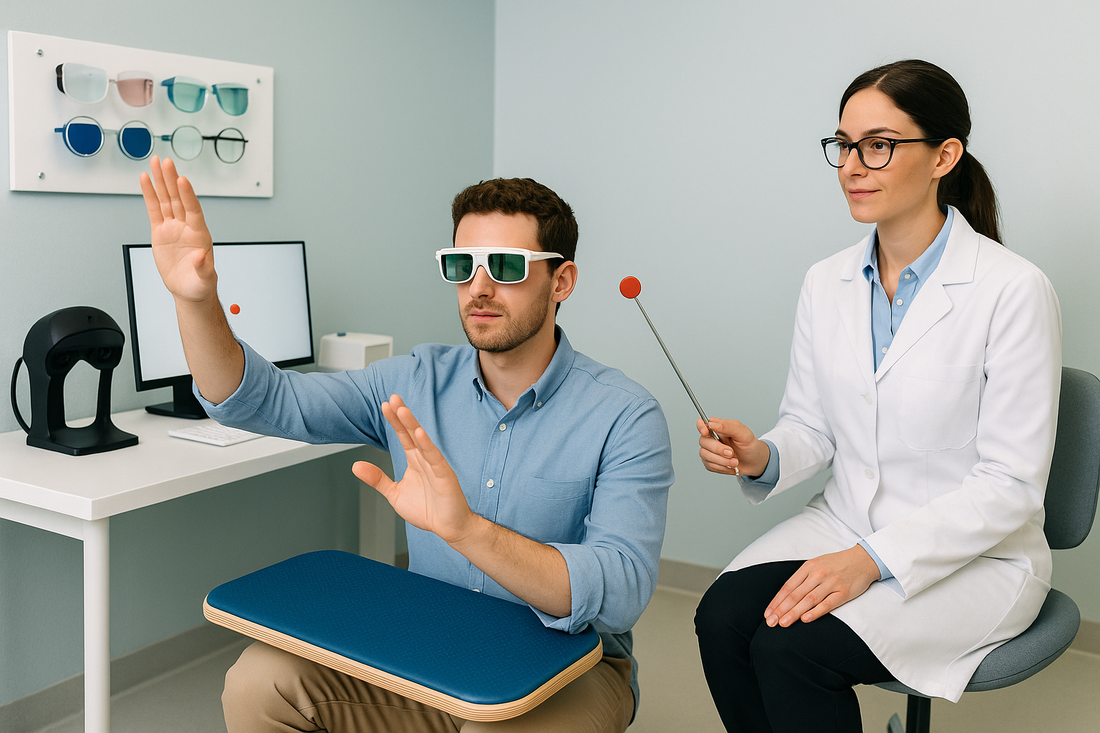Dry Eyes and Headaches: Why Vision Therapy Might Be the Missing Link
Many people with dry eyes and headaches are treating symptoms, not the cause. Vision therapy may hold the key to lasting relief by retraining your visual system for balance and comfort.

Dry Eyes and Headaches: How Vision Therapy Might Be What You Need
If you experience dry eyes, headaches, and trouble focusing — especially during screen time or reading — you’re not alone. For many people, these symptoms are connected not just to dryness but to how the eyes work together. What feels like “dryness” can sometimes be the result of strain, poor eye coordination, or visual fatigue. That’s where vision therapy comes in — a powerful but often overlooked approach that targets the root cause instead of only treating the symptoms.
Quick Navigation
1. The Connection Between Dry Eyes and Headaches
Most people think of dry eyes as a tear issue — not enough moisture, unstable tear film, or eyelids that don’t close completely. While those are valid causes, eye strain from poor visual coordination can mimic or worsen dryness symptoms.
Here’s what happens: when your eyes don’t align perfectly (often related to binocular vision dysfunction or convergence insufficiency), your brain constantly forces them to refocus. That effort creates tension in the small eye muscles and can alter blinking patterns — often causing incomplete blinks. Over time, that leads to faster tear evaporation, fatigue, and the burning or gritty feeling that defines dry eyes.
Meanwhile, the same overactive muscles responsible for these focusing efforts can trigger frontal headaches or temple pressure. This combination — dryness and pain — can become a self-perpetuating cycle, especially during long hours on screens.
2. How Visual Strain Affects Eye Moisture
Healthy blinking is essential for maintaining your tear film. Each blink spreads a thin layer of moisture across your eyes, keeping them smooth, oxygenated, and comfortable. But when your visual system is under constant demand — such as from screen use, poor alignment, or convergence insufficiency — your brain unconsciously suppresses blinking to maintain clarity of vision.
- Reduced blink rate: Screen users may blink up to 60% less frequently, accelerating evaporation.
- Incomplete blinks: Many people fail to close their eyes fully, leaving the cornea partially exposed.
- Evaporation acceleration: Less tear distribution means faster drying and more irritation.
This cycle of dryness → strain → headache often continues until the underlying visual imbalance is addressed.
3. What Vision Therapy Actually Does
Vision therapy is a structured program that retrains how your eyes work together. Unlike glasses, which correct optical clarity, therapy improves neuromuscular control — teaching your brain to coordinate focus, eye movement, and alignment efficiently. This helps reduce overuse of specific eye muscles and restores natural blinking and tear distribution.
Common components of vision therapy include:
- Eye-tracking exercises: Improve coordination and focus control for reading or screen tasks.
- Convergence training: Strengthens the ability to align both eyes when focusing on close objects.
- Relaxation techniques: Reduce excessive muscle tension that can lead to forehead or temple headaches.
- Visual endurance building: Gradually increases tolerance to sustained near work without fatigue.
Eye care specialists who offer vision therapy often perform a binocular vision assessment — testing eye alignment, fusion, and tracking ability. If these functions are imbalanced, your eyes may constantly “fight” to maintain clarity, creating both physical and neurological stress. Vision therapy corrects that imbalance through customized, progressive exercises.
4. Signs You Might Benefit from Vision Therapy
You might be a candidate for vision therapy if you notice these symptoms:
- Headaches after reading or computer work
- Dry or watery eyes that worsen with focus
- Difficulty concentrating or maintaining eye contact
- Words moving or doubling when reading
- Needing frequent breaks from close-up work
Even mild binocular vision dysfunction or oculomotor imbalance can cause a surprising amount of dryness and fatigue. If traditional treatments like artificial tears haven’t helped, it’s worth scheduling a comprehensive binocular vision exam — not just a standard refraction test.
5. Combining Vision Therapy with Moisture Protection
For many patients, the best results come from combining neuromuscular retraining (via vision therapy) with physical protection of the eyes, especially at night. During sleep, tear production naturally decreases. If your eyelids don’t seal completely (nocturnal lagophthalmos), even mild exposure can undo progress by allowing moisture to evaporate overnight.
Adding a gentle eyelid seal — like EyeOasis Sleeping Tape — helps preserve the tear film and protect sensitive ocular surfaces while your visual system adapts. Pair this with daytime habits that reduce strain: the 20-20-20 rule, ergonomic screen setup, and adequate hydration with omega-3–rich nutrition.
Shop the Solution
If your eyes often feel dry, strained, or tired — especially after long days of focus — pairing your vision therapy with gentle eyelid sealing can make a major difference. EyeOasis Sleeping Tape helps retain natural tears overnight, supporting recovery and restoring morning comfort.
Sources
- American Optometric Association. Vision Therapy and Eye Coordination Disorders.
- Sheedy JE, et al. Visual Fatigue and Binocular Vision Dysfunction. Optometry & Vision Science, 2003.
- Harrison W, et al. Sleep and Ocular Surface Health: The Overlap Between Dry Eye and Exposure. Cornea, 2018.
- Tsubota K, et al. Blinking and Ocular Surface Hydration in Screen Use. Ophthalmology, 1995.
